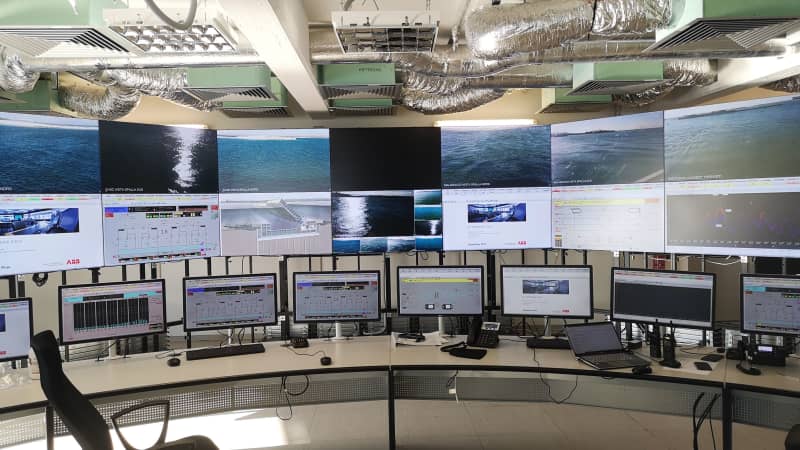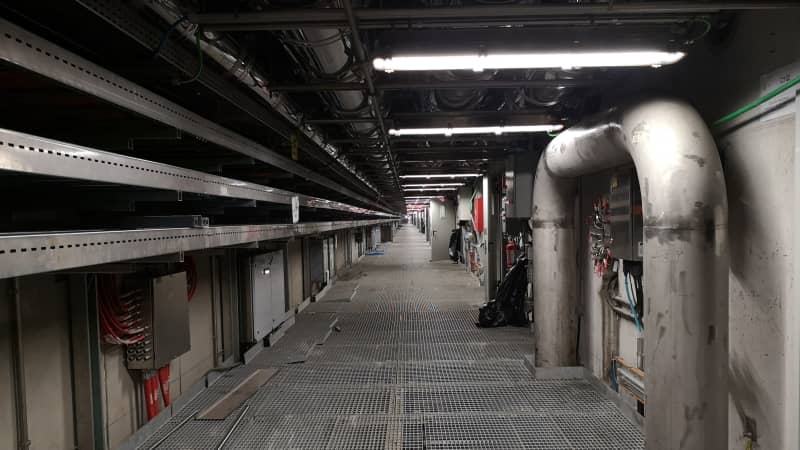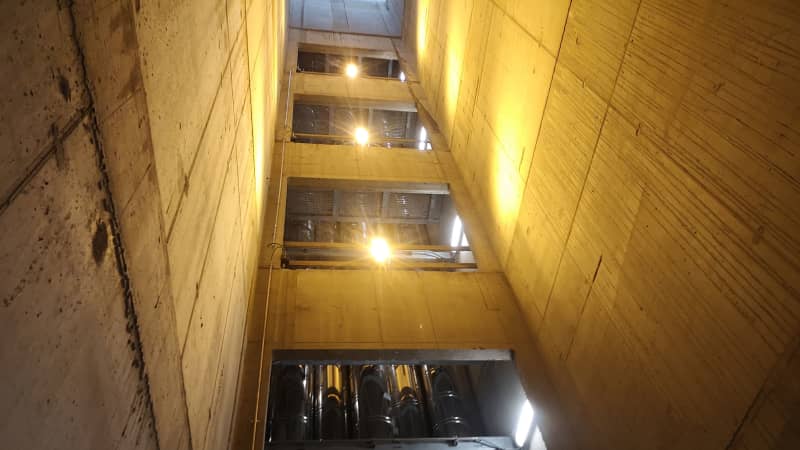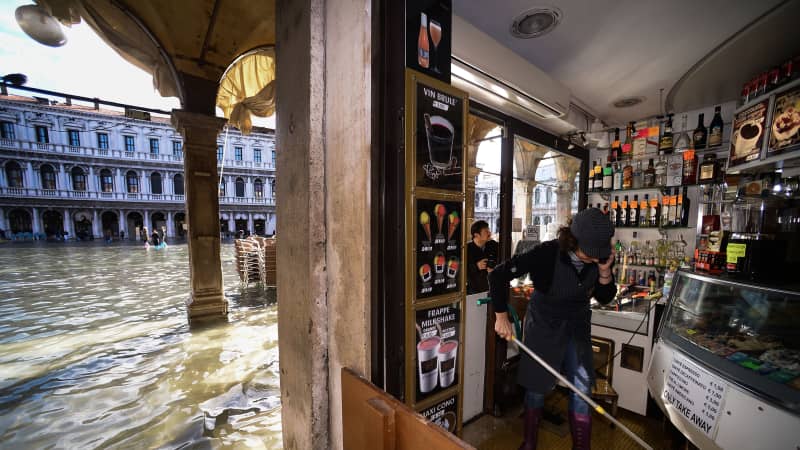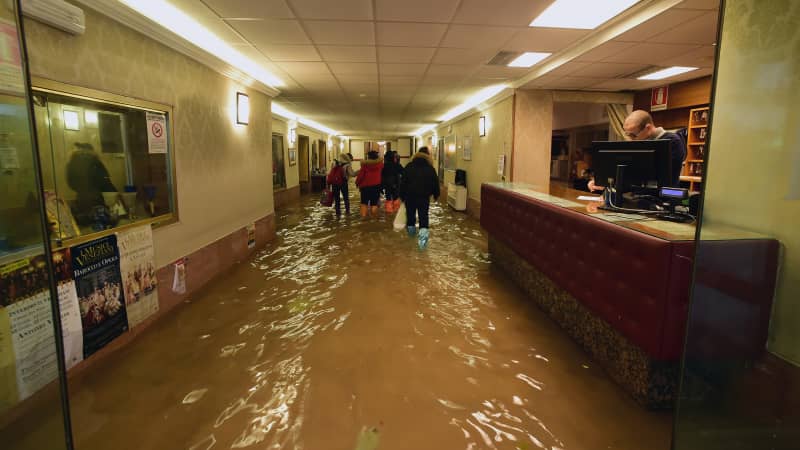(CNN) — The first thing it resembles — this private, manmade island, straddling the Adriatic Sea and the Venetian lagoon — is a Bond villain’s lair. The second — as you dock at the private pontoon, walk past the Brutalist concrete façade, and into a “control room” where staff watch monitors tracking the waters around the island 24/7 — is something out of “Squid Game.”
In fact, as sinister as it sounds, this 144,000 square meter (35.6 acre) island which keeps a silent tab on Venice around the clock isn’t a malign force — it’s there to protect one of the world’s most fragile cities.
The nameless island — situated between the peninsula of Cavallino-Treporti (which curls out from the Italian mainland, putting a protective arm around the Venetian lagoon) and the Lido island, a giant sandbar which blocks off most of the historical center of Venice from the Adriatic Sea — is the beating heart of the MOSE: the system of flood barriers that has, after 1,200 years, allowed the floating city to stand up to rising sea levels.
It has taken its time. The MOSE — Italian for Moses, and short for Modulo Sperimentale Elettromeccanico, or Experimental Electromechanical Model — has been in the works since 1984. But it took nearly four decades to build, being beset by delays and corruption to such an extent — a former mayor went on trial for embezzling money from the project — that many Venetians believed it would never work.
Their fears were proved groundless on October 3, 2020, however, when, as regularly happens in winter, Venice was hit by an exceptionally high tide.
Fourteen months later, the MOSE has been raised 33 times: 13 in 2020, and 20 so far in 2021. (The flooding period typically runs from October to March.) The naysayers appear to have been proven wrong — not once has it failed to protect the city when raised.
The yellow fins poking ever so slightly out of the sea tend to look fragile against the raging Adriatic, in footage taken when they’re raised — normally during storms whipped up by rough sirocco winds, which blast the city from the south.
But get up close, and you realize appearances can be deceptive. Each of these enormous barriers is 20-30 meters (66-98 feet) long, and 20 meters wide. They are embedded in the seabed in concrete chests, 40 meters wide, 60 meters long, and 10 meters high.
Oh, and there are 78 of them, spread in four lines, at the three entry points to the Venetian lagoon.
As a piece of infrastructure, the MOSE is a behemoth.
And yet, when the barriers are not in use, you don’t see a thing. Unlike flood barriers in northern Europe — and at much greater expense — the MOSE was designed to be invisible when the barriers are not needed.
A Bond-style island in no man’s land

The barriers at the Treporti inlet are split in two by an artificial island HQ.
Consorzio Venezia Nuova
The hub of the project is the specially constructed island floating in the middle of the northernmost entry point to the lagoon.
Overlooking the bucolic island of Sant’Erasmo, with the snow-tufted Dolomites on the horizon, it’s a “no man’s land between the sea and lagoon” where the lagoon and Adriatic waters converge, according to engineer and site director Alessandro Soru.
The “bocca di Treporti,” or Treporti inlet (“bocca” is Italian for mouth) is an almost mile-wide channel between Punta Sabbioni (the tip of Cavallino-Treporti) and the northernmost point of the Lido island.
There are two more entrypoints to the lagoon: at Malamocco, on the southern tip of the Lido, and another one at Chioggia, a fishing town at the southernmost point of the lagoon.
Treporti is by far the widest channel, though, and the level of the seabed varies from between 20 to 40 feet here. So, rather than create a massive barrier of varying height, the island has been created to divide the inlet into two. It also provides a space for the headquarters of the MOSE, which might otherwise disturb tourists in the campsites and beaches of Punta Sabbioni.
‘Proper James Bond’
Inside, a wall of monitors in the control room streams live CCTV footage of boats passing through the three channels. It also feeds in information on weather and tide levels, and monitors the barriers when they are raised.
One screen monitors the level of the lagoon and the sea levels: blue for the former, red for the latter.
On normal days, both blue and red lines rise and fall together like a heartbeat monitor — spiking at high tide, then hitting a trough at low.
On a recent date, however — December 8, 2021 — the lines spectacularly diverged.
The red line, denoting the Adriatic tide level, spiked high at 130 centimeters (51 inches) above the average, while the blue lagoon line followed it for a while, then plunged, then leveled out far below the red line, before eventually descending together.
On that date, at 8.58 p.m., the MOSE was raised as the tide hit 80 centimeters. That quick plunge? Physics — more specifically, the fluid dynamics of Bernoulli’s principle, meaning the lagoon level took a quick dip to 50 centimeters, before stabilizing at 80 centimeters for the next 12 hours. The MOSE was lowered at 8.44 a.m. the following day, when the two lines converged again.
In good weather, there are a couple of people here on day shift, as well as a team of four in the tunnel, 62 feet below, where half-mile tunnels in the concrete cases below the fins connect the island to the Lido and Punta Sabbioni, and the underwater humidity can be felt in your bones.
Warrens of pipes carrying the air to fill the barriers run underfoot in the tunnel, while chambers leading off from the side house the valves connecting the fins to the concrete bunkers. Each can be sealed off from the main corridor with the flick of a button, and it can operate even if, in a disaster, water gets in. Soru points to a porthole in the corner of the room: “That’s so you can get in via a sub, if it’s flooded — proper James Bond,” he says.
But when tides are high, this is the 24/7 hub of the whole operation, with a 100-strong team operating in the control room, in the underwater tunnels, and in the lagoon, as boats zip around to bring workers to the island — since there’s no public transport. There’s even accommodation so workers can sleep here between shifts.
How the MOSE works
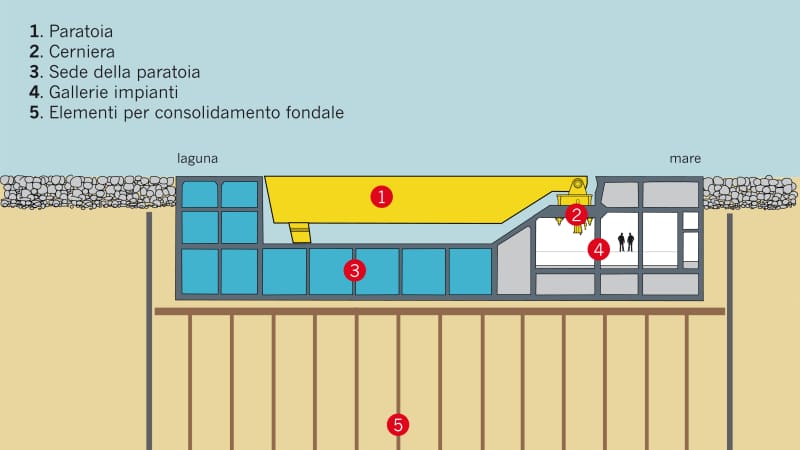
In normal weather, the yellow fin sits flush in its concrete case on the seabed.
Consorzio Venezia Nuova
After decades of initial controversy, the building of the MOSE began in 2009, with the last “fin” installed in June 2019, on the Lido side of the Treporti island.
The Venice lagoon is notoriously shallow — the average depth is just 1 meter (3.3 feet). But the inlets from the Adriatic are much deeper — Malamocco, the entrance to the industrial port is 14 meters (46 feet) deep, for example. Although they didn’t alter the depth of the inlets, engineers excavated the seabed along all three to make room for the concrete “cases,” which fit flush along the seabed.
The 14,000-ton cases were cast in concrete on the mainland, then floated into position and sunk beneath the water, while the debris removed from the seabed was used to build the island at Treporti — the “works citadel,” as Soru calls it.
Inside the concrete chests sit the metal floodgates, treated every three months with an anti-corrosive — non-toxic, because of the lagoon ecosystem. Each of the 78 barriers is a uniform 20 meters (65 feet) wide, and varies from 20-30 meters in length, depending on the depth of the water.
They can resist waves of up to 3 meters above normal tide levels — significantly more even than the record 194 centimeters (76 inches) tide that devastated the city in 1966.

Air is pumped into the fin, which raises it above the water. To lower it, the air is replaced with water.
Consorzio Venezia Nuova
How they work is down to a surprisingly simple hydraulics method. Lying dormant on the seabed, the hollow barriers are filled with water to weigh them down.
To raise them, air is pumped into the fins, as the water drains out. They float upwards until they emerge above the water — at which point they form a barrier with the Adriatic surging against them one side, the lagoon relatively calm — and low — on the other.
When the tide subsides, water is pumped back into the fins and air expelled, causing them to sink down again and settle in their cases. It takes just 32 minutes to raise them, and about half that to lower them — that’s down from 91 minutes last year, according to Elisabetta Spitz, the “extraordinary commissioner” responsible for the project, who reports to the Italian government.
The process sounds simple, but has been honed to a precise degree. Between each barrier is an almost 3-inch gap, to release some of the intense pressure on the fins as they withstand the Adriatic. For the same reason, they’re raised four or five at a time, instead of all at once. They can work independently, too — so engineers can choose to raise just some of the barriers, to slow down the flow of water into the lagoon, or lower them temporarily at Malamocco to let an industrial ship go through to Venice’s port — Italy’s second busiest, and the fifth in the Mediterranean.
That also means, says Soru, that if, as people fear, one barrier ever fails to raise, it won’t stop the MOSE working as a whole. Not that that’s happened in the year that it’s been protecting the city.
Finger on the button
Deciding to raise the barriers is a complicated process. Two establishments study the weather predictions: the Centro Maree di Venezia, which monitors tide levels for the city, and the Sala Operativa Consorzio Venezia Nuova, which is responsible for the MOSE. Both use different modeling, and compare their forecasts.
Spitz calls the process a “series of warnings, from 48 hours before the tide until three hours before.”
It’s not just the MOSE operatives who receive it. “It informs everyone who operates in the lagoon to get going, because everyone has to do something — from the guy driving the trash-collecting boat who needs to change course, to ships needing to go in and out,” she explains.
Fifteen minutes before that three-hour warning, Spitz and a government representative get an email, “summarizing everything that’s happened in the preceding hours and asking for confirmation to proceed.
“For example, if there’s a ship running late because it’s been caught in bad weather, we can decide to leave a part of the barrier open to let it in.
“We intervene only if there are exceptional events that mean we need to deviate from the procedure. If not the procedure goes ahead without intervention.”
It’s not just sea level and wind speed that they need to take into account — rainfall raises the water level around the city, as do swollen rivers disgorging into the lagoon. “Even if a tide of 95cm is predicted, we don’t know if the barriers will go up,” says Soru.
Last year, on December 8, Venice was hit by a 138cm flood, causing extensive damage to the city, just weeks after the MOSE had shown it never need happen again. The reason? Only 125cm had been predicted, but wind, rain and river water rocketed the sea level up.
“I take responsibility for it,” says Spitz. “It was one of the first raisings, we had a procedure that was a bit more complicated and as acqua alta [flooding] wasn’t predicted, we took the decision to not mobilize it.
“But it was one of the first tries, and we understood the process needed to be made more automatic, so we updated the procedure. It was our fault. But today it wouldn’t happen.”
“It was disastrous, but we learn from experience — now we raise the barriers a few centimeters earlier,” says Soru.
When the MOSE is fully operational in 2023, the barriers will be raised when the water level hits 110cm (43in) above the regular level. That won’t help the lowest areas of the city, such as St. Mark’s Square which floods at around 90cm; but it will protect around 86% of Venice, including most residential areas.
In fact, says Soru, the barriers will be raised when it looks like the tide will hit 100cm, to account for wind and rain raising the water levels.
For now, though, with the barriers in a final stage of tests, they’re raised when the tide is predicted to hit 130cm.
The criticism
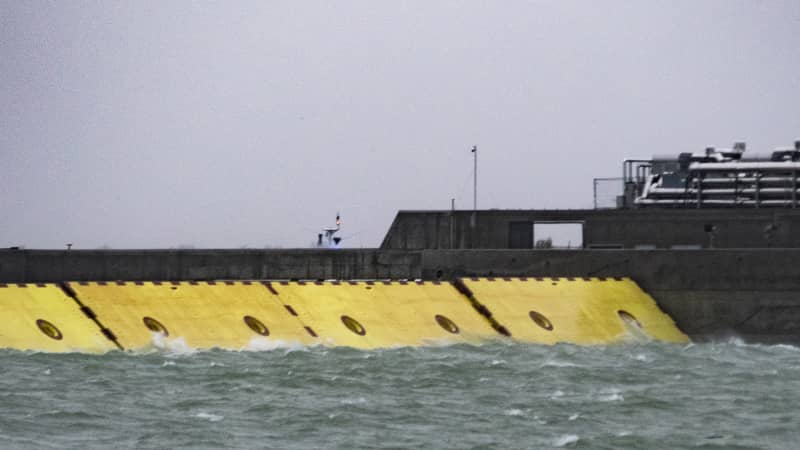
The barriers raised for the first time in bad weather on October 3, 2020.
Simone Padovani/Awakening/Getty Images
Of course, projects of this size are rarely without their detractors. One of the main criticisms leveled at the MOSE is that the barriers interfere with the lagoon ecosystem, turning it into a pond rather than a living lagoon.
But, says Spitz, when the barriers were up for 48 hours last year, that was as a trial, to test their resistance. In the future, even in periods when the barriers are up daily, it will only be for a few hours at a time. They have also installed locks at Chioggia and Malamocco to enable some fishing vessels and industrial ships to pass while the barriers are up.
“When it goes up, it’s three, four hours maximum,” she says. “And then it’s not a given that you have to raise all the barriers. There are many possibilities and much flexibility. We’re trialing all of them to target choices better to the needs that will gradually show up. Every time we do a raise, we prepare dozens of tests to get the answers we need, understand the function and make it better.”
Spitz insists that she didn’t choose the cut-off points — a committee of local and national governance did. Access to the port was also taken into consideration.
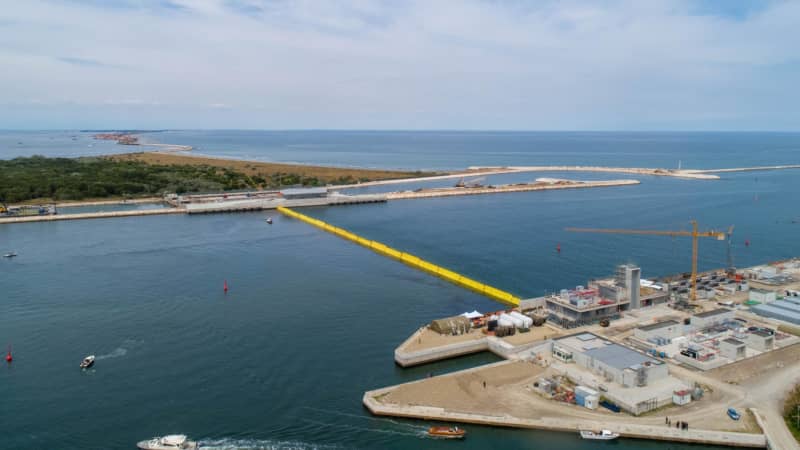
When raised, the barriers cut off the three main entry points to the lagoon.
Consorzio Venezia Nuova
“We need to save Venice, Chioggia, the islands — Murano, Burano, and lots of small islands are even worse off in front of high tides,” she says.
“But above all we need to find a point of mediation between economic needs — of those who operate in the lagoon — and the need to protect. That’s the big question we’ll need to take forward down the line.”
Coping with climate change
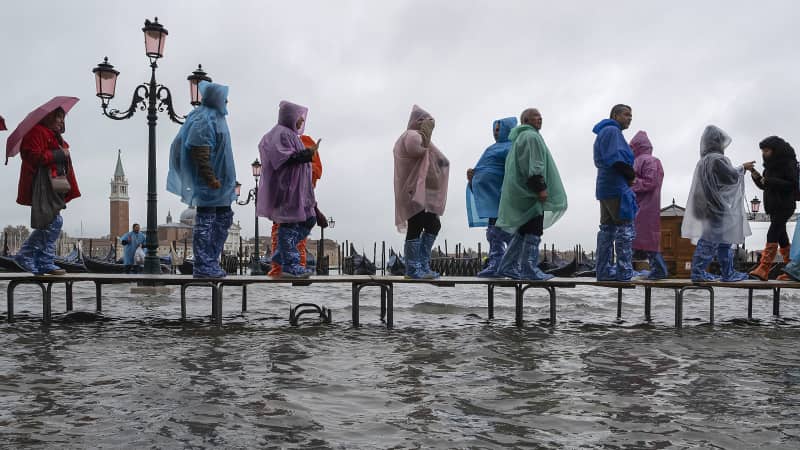
Tourists typically navigate Venice flooding on raised walkways.
Stefano Mazzola/Awakening/Getty Images
The big question, of course, is how the MOSE can hold up to climate change.
“Now with the worsening climate crisis, the water level is always higher, and we see that kind of tide level 20 times a year — what will happen in 30 years?”, he asked.
Spitz and Soru, however, insist that the barriers will last longer than that.
“A study on corrosion we did a few months ago said that it can last for 100 years, but must be maintained every three months,” says Soru.
“If in 100 years the barriers aren’t enough, and we can’t hold off 3-meter tides, I can tell you the problem won’t be Venice,” adds Spitz.
“The lagoon is closed now. The protection is more than sufficient, the barriers are what they are. But you would need to think about protecting other areas — the problem would be much more in the Po delta [which covers much of northern Italy].
“If climate change is dramatic, there will be serious problems elsewhere. You’d need to look elsewhere, not at Venice.”
In the meantime, plans have been mooted to partially power the MOSE through solar panels. Installing them at Malamocco could provide 20% of power — but Spitz hopes to make the project carbon neutral within three years, to stand it in good stead for the future.
Spitz arrived in 2019, well after the corruption trials of the MOSE. “I know there were scandals, I’ve read about them, and it’s right that they’re stigmatized and the people who did it were punished,” she says.
“But despite everything that happened with the MOSE, I say, long live the MOSE. Because it protects Venice.”
If she’s right, the devastating flood of November 2019 — which killed two and caused $1 billion damage to local businesses which have yet to recover, might be a thing of the past. And La Serenissima can rest a little more, well, serene.

